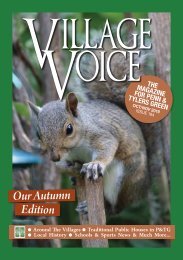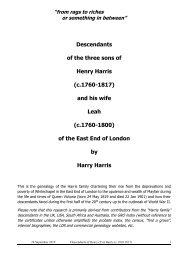VV_Web DEC 19
You also want an ePaper? Increase the reach of your titles
YUMPU automatically turns print PDFs into web optimized ePapers that Google loves.
FIELDS IN
KING'S WOOD Part 3
So far, we have established that LiDAR
images unexpectedly reveal clear evidence
of what appear to be field boundaries in
King's Wood and that the underlying
geology is not the unploughable clay which
usually underlies woodland, but is the soft
chalk favoured by early farmers. We
ended Part 2 asking whether there is any
evidence of when it was not woodland and
these fields were being ploughed.
Bassetsbury Manor
King's Wood and the neighbouring St John's
Wood to its north were not separated until 1203
when the manor of Wycombe was divided
between two lords, Alan Basset and Robert
Vipont. The open area around Kingswood
House, immediately east of Kingswood Road, is
a surviving part of St John's Wood, but a
lynchet (a sharp change of slope resulting from
ploughing) continues the King's Wood contours
ignoring the boundary between the woods.(see
map). This suggests that the formation of the
lynchet, and
hence
evidence of
ploughing,
preceded
the division
of 1203.
An
agreement
in 1224
between the
two lords
and the
commoners
refers to
enclosed
www.pennandtylersgreen.org.uk
Village Voice December 2019/January 2020
land near Hazlemere, but otherwise refers only
to the commoners' rights to the pannage for pigs
in the adjoining woods of Wycombe and of
Penn. King's Wood was held by Bassetsbury
Manor and its name and description as a wood
could date from when Henry III (1216-72) held
it in his own hands as part of Bassetsbury manor
for some years. The name St John's Wood
must be from 1312 when it passed into the
ownership of the Knights Hospitaller of St John
of Jerusalem
There is no mention in the Bassetsbury
manorial records of any fields in King's Wood.
It is all about trees, such as in 1541 when 'ten
hundred beche trees of the best and biggest in a
wood or grove called Kynges woode' were sold
for £25. Nor is there any reference to fields in
the records of two Inquiries into rights of
common on Wycombe Heath in 1576 and 1666.
The commoners claimed that both St John's
Wood and King's Wood were used as common
by the surrounding inhabitants and that 'they
had always taken underwood.... thorns, bushes,
holly and hazel...and had dug chalk in King's
Wood.'
Thus we can say with some confidence that
King's Wood was woodland as far back as this
medieval evidence can take us. Next time we
must look at Domesday Book and for any
earlier Saxon evidence. Miles Green
37
















